Research Progress and Development of Near-Infrared Phosphors
Abstract
:1. Introduction
2. Analysis of Application Fields
2.1. Modern Agriculture
2.2. Security Monitoring
2.3. Food/Medical Testing
3. Introduction of Light-Emitting Device
3.1. Incandescent Bulb
3.2. Halogen Lamp
3.3. (Al, Ga) As-Based LED
3.4. NIR Phosphor-Converted LED (NIR pc-LED)
4. Research Status of NIR Phosphor
4.1. NIR Phosphor Activated by Lanthanides
4.1.1. NIR Phosphor Activated by Yb3+
4.1.2. NIR Phosphor Activated by Er3+
4.1.3. NIR Phosphor Activated by Nd3+
4.1.4. NIR Phosphor Activated by Ho3+
4.1.5. NIR Phosphor Activated by Tm3+
4.1.6. NIR Phosphor Activated by Eu2+
4.2. NIR Phosphor Activated by Main-Group Metal
4.2.1. NIR Phosphor Activated by Bismuth
4.2.2. NIR Phosphor Activated by Sn2+
4.3. NIR Phosphor Activated by Transition Metals
4.3.1. NIR Phosphor Activated by Fe3+
4.3.2. NIR Phosphor Activated by Ni2+
4.3.3. NIR Phosphor Activated by Manganese
4.3.4. NIR Phosphor Activated by Cr3+
4.3.5. NIR Phosphor Activated by Cr4+
5. Conclusions and Outlook
Author Contributions
Funding
Institutional Review Board Statement
Informed Consent Statement
Data Availability Statement
Acknowledgments
Conflicts of Interest
References
- Lim, S.R.; Kang, D.; Ogunseitan, O.A.; Schoenung, J.M. Potential Environmental Impacts from the Metals in Incandescent, Compact Fluorescent Lamp (CFL), and Light-Emitting Diode (LED) Bulbs. Environ. Sci. Technol. 2013, 47, 1040–1047. [Google Scholar] [CrossRef] [PubMed]
- Tanno, H. Near-Infrared Light-Emitting Phosphor, Phosphor Mixture, Light-Emitting Element, and Light-Emitting Device. U.S. Patent 2021155850, 27 May 2021. [Google Scholar]
- Ye, M.Q.; Gao, Z.P.; Li, Z.; Yuan, Y.H.; Yue, T.L. Rapid detection of volatile compounds in apple wines using FT-NIR spectroscopy. Food Chem. 2016, 190, 701–708. [Google Scholar] [CrossRef] [PubMed]
- Guelpa, A.; Marini, F.; Plessis, D.A.; Slabbert, R.; Manley, M. Verification of authenticity and fraud detection in South African honey using NIR spectroscopy. Food Control 2017, 73, 1388–1396. [Google Scholar] [CrossRef]
- Eggebrecht, A.T.; Ferradal, S.L.; Robichaux-Viehoever, A.; Hassanpour, M.S.; Dehghani, H.; Snyder, A.Z.; Hershey, T.; Culver, J.P. Mapping distributed brain function and networks with diffuse optical tomography. Nat. Photon. 2014, 8, 448–454. [Google Scholar] [CrossRef] [PubMed]
- Goins, G.D.; Yorio, N.C.; Sanwo, M.M.; Brown, C.S. Photomorphogenesis, photosynthesis, and seed yield of wheat plants grown under red light-emitting diodes (LEDs) with and without supplemental blue lighting. J. Exp. Bot. 1997, 4, 1407–1413. [Google Scholar] [CrossRef]
- Tamulaitis, G.; Duchovskis, P.; Bliznikas, Z.; Breive, K.; Ulinskaite, R.; Brazaityte, A.; Novickovas, A.; Zukauskas, A.; Shur, M.S. High-power LEDs for plant cultivation. J. Phys. D Appl. Phys. 2005, 38, 3182–3187. [Google Scholar] [CrossRef]
- Chen, W.C. Application of 730 nm Far Red Light LEDs in Horticulture Lighting. China Light Light. 2015, 8, 29–31. [Google Scholar]
- Youn, J.S.; Lee, M.J.; Park, K.Y.; Choi, W.Y. 10-Gb/s 850-nm CMOS OEIC receiver with a silicon avalanche photodetector. IEEE J. Quantum. Elect. 2012, 48, 229–236. [Google Scholar] [CrossRef]
- Lee, M.J.; Youn, J.S.; Park, K.Y.; Choi, W.Y. A fully-integrated 125-Gb/s 850-nm CMOS optical receiver based on a spatially-modulated avalanche photodetector. Opt. Express 2014, 22, 2511–2518. [Google Scholar] [CrossRef]
- Zeng, B.; Huang, Z.; Singh, A.; Yao, Y.; Azad, A.K.; Mohite, A.D.; Taylor, A.J.; Smith, D.R.; Chen, H.T. Hybrid graphene metasurfaces for high-speed mid-infrared light modulation and single-pixel imaging. Light Sci. 2018, 7, 51. [Google Scholar] [CrossRef]
- Petach, A.R.; Toomey, M.; Aubrecht, D.M.; Richardson, A.D. Monitoring vegetation phenology using an infrared-enabled security camera. Agric. For. Meteorol. 2014, 195, 143–151. [Google Scholar] [CrossRef]
- Hotmartua, R.; Pangestu, P.W.; Zakaria, H.; Irawan, Y.S. Noninvasive blood glucose detection using near infrared sensor. In Proceedings of the International Conference on Electrical Engineering & Informatics, Denpasar, Indonesia, 10–11 August 2015; pp. 687–692. [Google Scholar]
- Widagdo, S. Incandescent Light Bulb: Product Design and Innovation. Ind. Eng. Chem. Res. 2006, 45, 8231–8233. [Google Scholar] [CrossRef]
- Tehfe, M.A.; Lalevée, J.; Telitel, S.; Sun, J.; Zhao, J.; Graff, B.; Morlet-Savary, F.; Fouassier, J.P. Iridium complexes incorporating coumarin moiety as catalyst photoinitiators: Towards household green LED bulb and halogen lamp irradiation. Polymer 2012, 53, 2803–2808. [Google Scholar] [CrossRef]
- Yamakoshi, S.; Hasegawa, O.; Hamaguchi, H.; Abe, M.; Yamaoka, T. Degradation of high-radiance Ga1−xAlxAs LED’s. Appl. Phys. Lett. 1977, 31, 627. [Google Scholar] [CrossRef]
- Trifunovic, J.; Mikulovic, J.; Djurisic, Z.; Djuric, M.; Kostic, M. Reductions in electricity consumption and power demand in case of the mass use of compact fluorescent lamps. Energy 2009, 34, 1355–1363. [Google Scholar] [CrossRef]
- Roberto, F.; Emanuele, T.; Mauro, R. LEDs: Sources and intrinsically bandwidth-limited detectors. Sensors 2017, 17, 1673. [Google Scholar]
- Nagata, N.; Nakanotani, H.; Adachi, C. Near-infrared electrophosphorescence up to 1.1 µm using a thermally activated delayed fluorescence molecule as triplet sensitizer. Adv. Mater. 2017, 29, 1604265. [Google Scholar] [CrossRef]
- Ventura, M.; de Jager, A.; de Putter, H.; Roelofs, F.P. Non-destructive determination of soluble solids in apple fruit by near infrared spectroscopy (NIRS). Postharvest Biol. Technol. 1998, 14, 21–27. [Google Scholar] [CrossRef]
- Ye, S.; Jiang, N.; He, F.; Liu, X.F.; Zhu, B.; Yu, T.; Qiu, J.R. Intense near-infrared emission from ZnO-LiYbO2 hybrid phosphors through efficient energy transfer from ZnO to Yb3+. Opt. Express 2010, 18, 639–644. [Google Scholar] [CrossRef]
- Schenkman, B.N.; Kjell, B. Camera position and presentation scale for infrared night vision systems in cars. Human Factor. Ergon. Man. 2010, 17, 457–473. [Google Scholar] [CrossRef]
- Xia, Z.G.; Liu, Q.L. Progress in discovery and structural design of color conversion phosphors for LEDs. Prog. Mater. Sci. 2016, 84, 59–117. [Google Scholar] [CrossRef]
- Zhou, Y.; Hu, Y.; Liu, R.; Liu, Y.; Zhuang, W.; Cao, M.; Gao, T.; Tian, J.; Li, Y.; Chen, G. Blue-emitting Sr1−xCaxLu2O4:Ce3+ phosphors for high CRI white LEDs. J. Rare Earth. 2021, 6, 627–633. [Google Scholar] [CrossRef]
- Rajendran, V.; Fang, M.H.; Guzman, G.N.D.; Lesniewski, T.; Mahlik, S.; Grinberg, M.; Leniec, G.; Kaczmarek, S.M.; Lin, Y.S.; Lu, K.M.; et al. Super broadband near-infrared phosphors with high radiant flux as future light sources for spectroscopy applications. ACS Energy Lett. 2018, 3, 2679–2684. [Google Scholar] [CrossRef]
- Huang, X.; Han, S.; Huang, W.; Liu, X. Enhancing solar cell efficiency: The search for luminescent materials as spectral converters. Chem. Soc. Rev. 2013, 42, 173. [Google Scholar] [CrossRef]
- Li, Y.; Gecevicius, M.; Qiu, J. Long persistent phosphors-from fundamentals to applications. Chem. Soc. Rev. 2016, 45, 2090–2136. [Google Scholar] [CrossRef] [PubMed]
- Ferhi, M.; Hassen, N.B.; Bouzidi, C.; Horchani-Naifer, K.; Ferid, M. Near-infrared luminescence properties of Yb3+, doped LiLa(PO3)4, powders. J. Lumin. 2016, 170, 174–179. [Google Scholar] [CrossRef]
- Goncalves, T.S.; Silva, R.J.M.; de Oliveira Junior, M.; Ferrari, C.R.; Poirier, G.Y.; Eckert, H.; de Camargo, A.S. Structure-property relations in new fluorophosphate glasses singly- and co-doped with Er3+, and Yb3+. Mater. Chem. Phys. 2015, 157, 45–55. [Google Scholar] [CrossRef]
- Li, H.; Pang, R.; Zhang, S.; Lv, L.; Feng, J.; Jiang, L.; Li, D.; Li, C.; Zhang, H. Developing near-infrared long-lasting phosphorescence of Yb3+ through medium: Energy-transfer insight in novel material Zn1.98Li0.02P2O7: Yb3+. Dalton Trans. 2018, 47, 9814–9823. [Google Scholar] [CrossRef]
- Xiang, G.; Ma, Y.; Zhou, X.; Jiang, S.; Li, L.; Luo, X.; Hao, Z.; Zhang, X.; Pan, G.H.; Luo, Y.; et al. Investigation of the Energy-Transfer Mechanism in Ho3+- and Yb3+-Codoped Lu2O3 Phosphor with Efficient Near-Infrared Downconversion. Inorg. Chem. 2017, 56, 1498–1503. [Google Scholar] [CrossRef]
- Mi, L.; Xu, J.; Feng, Y.; Cao, L.; Xue, M.; Huang, Y.; Chen, C.; Seo, H.J. Wavelength conversion of Yb3+-activated Y4CdMo3O16 from near UV-region to IR emission. Mater. Chem. Phys. 2018, 204, 216–221. [Google Scholar] [CrossRef]
- Snitzer, E.; Woodcock, R. Yb3+, Er3+ GLASS LASER. Appl. Phys. Lett. 1965, 6, 45–46. [Google Scholar] [CrossRef]
- Nakazawa, M.; Tokuda, M.; Washio, K. Asahara 130-km-long fault location for single-mode optical fiber using 1.55-μm Q-switched Er3+: Glass laser. Opt. Lett. 1984, 9, 312–314. [Google Scholar] [CrossRef] [PubMed]
- Desurvire, E.; Simpson, J.R.; Becker, P.C. High-gain erbium-doped traveling-wave fiber amplifier. Opt. Lett. 1987, 12, s888–s890. [Google Scholar] [CrossRef] [PubMed]
- Hemmer, E.; Venkatachalam, N.; Hyodo, H.; Hattori, A.; Ebina, Y.; Kishimoto, H.; Soga, K. Upconverting and NIR emitting rare earth based nanostructures for NIR-bioimaging. Nanoscale 2013, 5, 11339–11361. [Google Scholar] [CrossRef]
- Xu, J.; Murata, D.; Ueda, J.; Tanabe, S. Near-infrared long persistent luminescence of Er3+ in garnet for the third bio-imaging window. J. Mater. Chem. C 2016, 4, 11096–11103. [Google Scholar] [CrossRef]
- Lei, X.; Li, R.; Tu, D.; Shang, X.; Liu, Y.; You, W.; Sun, C.; Zhang, F.; Chen, X. Intense near-infrared-II luminescence from NaCeF4: Er/Yb nanoprobes for in vitro bioassay and in vivo bioimaging. Chem. Sci. 2018, 9, 4682–4688. [Google Scholar] [CrossRef]
- Qian, Y.; Wang, R.; Wang, B.; Zhang, B.; Gao, S. Strong 1550 nm to visible luminescence in In/Er/Yb:LiNbO3 crystal considered as an upconverter for solar cells. RSC Adv. 2014, 4, 6652–6656. [Google Scholar] [CrossRef]
- Ye, S.; Song, E.H.; Ma, E.; Zhang, S.J.; Wang, J.; Chen, X.Y.; Zhang, Q.Y.; Qiu, J. Broadband Cr3+-sensitized upconversion luminescence in La3Ga5GeO14:Cr3+,Yb3+,Er3+. Opt. Mater. Express 2014, 4, 638–648. [Google Scholar] [CrossRef]
- Chen, B.; Chu, S.T.; Pun, E.Y.B.; Lin, H. Nd3+-doped ion-exchanged aluminum germanate glass channel waveguide. Opt. Mater. Express 2015, 5, 113–123. [Google Scholar] [CrossRef]
- Ding, L.; Zhang, Q.; Luo, J.; Liu, W.; Zhou, W.; Yin, S. Preparation, structure and photoluminescence of nanoscaled-Nd:Lu3Al5O12. J. Alloys Compd. 2011, 509, 10167–10171. [Google Scholar] [CrossRef]
- Talewar, R.A.; Joshi, C.P.; Moharil, S.V. Sensitization of Nd3+, near infrared emission in Ca2PO4Cl host. J. Lumin. 2018, 197, 1–6. [Google Scholar] [CrossRef]
- Möller, S.; Katelnikovas, A.; Haase, M.; Jüstel, T. New NIR emitting phosphor for blue LEDs with stable light output up to 180 °C. J. Lumin. 2016, 4, 185–190. [Google Scholar] [CrossRef]
- Meng, J.X.; Li, J.Q.; Shi, Z.P.; Cheah, K.W. Efficient energy transfer for Ce to Nd in Nd/Ce codoped yttrium aluminum garnet. Appl. Phys. Lett. 2008, 93, 1908–1911. [Google Scholar] [CrossRef]
- Allain, J.Y.; Le Flohic, M.; Monerie, M.; Poignant, H. Holmium in ZBLAN: Interplay of lasing, co-lasing and excited-state absorption. J. Non-Cryst. Solids 1993, 161, 222–226. [Google Scholar] [CrossRef]
- Yu, D.C.; Huang, X.Y.; Ye, S. Three-photon near-infrared quantum splitting in β-NaYF4:Ho3+. Appl. Phys. Lett. 2011, 99, 161904. [Google Scholar] [CrossRef]
- Brenier, A.; Courrol, L.C.; Pedrini, C.; Madej, C.; Boulon, G. Excited state absorption and looping mechanism in Yb3+-Tm3+-Ho3+-doped Gd3Ga5O12, garnet. Opt. Mater. 1994, 3, 25–33. [Google Scholar] [CrossRef]
- Yu, T.; Yu, D.C.; Lin, H.H.; Zhang, Q.Y. Single-band near-infrared quantum cutting of Ho3+-Yb3+ codoped KLu2F7 phosphors by energy clustering. J. Alloys Compd. 2016, 695, 1154–1159. [Google Scholar] [CrossRef]
- Chen, X.; Salamo, G.J.; Li, S.; Wang, J.; Guo, Y.; Gao, Y.; He, L.; Ma, H.; Tao, J.; Sun, P.; et al. Two-photon, three-photon, and four-photon excellent near-infrared quantum cutting luminescence of Tm3+ ion activator emerged in Tm3+: YNbO4, powder phosphor one material simultaneously. Phys. B Phys. Condens. Matter 2015, 479, 159–164. [Google Scholar] [CrossRef]
- Wang, Y.Z.; Yu, D.C.; Lin, H.H.; Ye, S.; Peng, M.Y.; Zhang, Q.Y. Broadband three-photon near-infrared quantum cutting in Tm3+ singly doped YVO4. J. Appl. Phys. 2013, 114, 203510. [Google Scholar] [CrossRef]
- Geusic, J.E.; Ostermayer, F.W.; Marcos, H.M.; Van Uitert, L.G.; Van der Ziel, J.P. Efficiency of Red, Green, and Blue Infrared-to-Visible Conversion Sources. J. Appl. Phys. 1971, 42, 1958–1960. [Google Scholar] [CrossRef]
- Kim, K.B.; Kim, Y.I.; Chun, H.G.; Cho, T.Y.; Jung, J.S.; Kang, J.G. Structural and Optical Properties of BaMgAl10O17:Eu2+ Phosphor. Chem. Mater. 2003, 34, 5045–5052. [Google Scholar] [CrossRef]
- Barry, T.L. Fluorescence of Eu2+ Activated Phases in Binary Alkaline Earth Orthosilicate Systems. J. Electrochem. Soc. 1968, 115, 1181–1183. [Google Scholar] [CrossRef]
- Uheda, K.; Hirosaki, N.; Yamamoto, Y.; Naito, A.; Nakajima, T.; Yamamoto, H. Luminescence properties of a red phosphor, CaAlSiN3:Eu2+, for white light-emitting diodes. Electrochem. Solid-State Lett. 2006, 9, H22–H25. [Google Scholar] [CrossRef]
- Qiao, J.; Zhou, G.; Zhou, Y.; Zhang, Q.; Xia, Z. Divalent europium-doped near-infrared-emitting phosphor for light-emitting diodes. Nat. Commun. 2019, 10, 5267. [Google Scholar] [CrossRef] [PubMed]
- Qiao, J.; Zhang, S.; Zhou, X.; Chen, W.; Gautier, R.; Xia, Z. Near-infrared light-emitting diode utilizing europium-activated calcium oxide phosphor with external quantum efficiency of up to 54.7%. Adv. Mater. 2022, 34, 2201887. [Google Scholar] [CrossRef] [PubMed]
- Yadav, R.S.; Dwivedi, Y.; Rai, S.B. Structural and Optical Analysis of Eu3+ Doped BiVO4 Nanophosphor by Combustion Method. Appl. Mech. Mater. 2015, 752–753, 272–276. [Google Scholar] [CrossRef]
- Ren, J.; Qiu, J.; Chen, D.; Wang, C.; Jiang, X.; Zhu, C. Infrared luminescence properties of bismuth-doped barium silicate glasses. J. Mater. Res. 2007, 22, 1954–1958. [Google Scholar] [CrossRef]
- Cao, R.; Peng, M.; Zheng, J.; Qiu, J.; Zhang, Q. Superbroad near to mid infrared luminescence from closo-deltahedral Bi53+ cluster in Bi5(GaCl4)3. Opt. Express 2012, 20, 18505–18514. [Google Scholar] [CrossRef] [PubMed]
- Mizoguchi, H.; Woodward, P.M.; Park, C.H.; Keszler, D.A. Strong near-infrared luminescence in BaSnO3. J. Am. Chem. Soc. 2004, 126, 9796–9800. [Google Scholar] [CrossRef]
- Kniec, K.; Tikhomirov, M.; Pozniak, B.; Ledwa, K.; Marciniak, L. LiAl5O8:Fe3+ and LiAl5O8:Fe3+, Nd3+ as a new luminescent nanothermometer operating in 1st biological optical window. Nanomaterials 2020, 189, 10. [Google Scholar] [CrossRef] [PubMed]
- Liu, D.; Li, G.; Dang, P.; Zhang, Q.; Wei, Y.; Qiu, L.; Molokeev, M.S.; Lian, H.; Shang, M.; Lin, J. Highly efficient Fe3+-doped A2 BB′O6 (A = Sr2+, Ca2+; B, B′ = In3+, Sb5+, Sn4+) broadband near-infrared-emitting phosphors for spectroscopic analysis. Light Sci. Appl. 2022, 11, 112. [Google Scholar] [CrossRef]
- Zhang, X.; Chen, D.; Chen, X.; Zhou, C.; Chen, P.; Pang, Q.; Zhou, L. Broadband near-infrared luminescence from Fe3+-activated NaScSi2O6 phosphors for luminescence thermometry and night-vision applications. Dalton Trans. 2022, 51, 14243–14249. [Google Scholar] [CrossRef]
- Zhou, S.; Jiang, N.; Wu, B.; Hao, J.; Qiu, J. Ligand-driven wavelength-tunable and ultra-broadband infrared luminescence in single-ion-doped transparent hybrid materials. Adv. Funct. Mater. 2010, 19, 2081–2088. [Google Scholar] [CrossRef]
- Donegan, J.F.; Bergin, F.J.; Glynn, T.J.; Imbusch, G.F.; Remeika, J.P. The optical spectroscopy of LiGa5O8: Ni2+. J. Lumin. 1986, 35, 57–63. [Google Scholar] [CrossRef]
- Botao, W.; Jian, R.; Jinjun, R.; Danping, C.; Congshan, Z.; Shifeng, Z.; Jianrong, Q. Enhanced broadband near-infrared luminescence in transparent silicate glass ceramics containing Yb3+ ions and Ni2+-doped LiGa5O8 nanocrystals. Appl. Phys. Lett. 2008, 92, 041110. [Google Scholar]
- Liu, F.; Liang, Y.; Chen, Y.; Pan, Z. Divalent nickel-activated gallate-based persistent phosphors in the short-wave infrared. Adv. Opt. Mater. 2016, 4, 562–566. [Google Scholar] [CrossRef]
- Zhang, X.; Li, Y.; Hu, Z.; Chena, Z.; Qiu, J. A general strategy for controllable synthesis of Ba3(MO4)2:Mn5+ (M = V, P) nanoparticles. RSC Adv. 2017, 7, 10564–10569. [Google Scholar] [CrossRef]
- Herren, M.; Riedener, T.; Güdel, H.U.; Albrecht, C.; Kaschuba, U.; Reinen, D. Near-infrared luminescence of manganate(V)-doped phosphates and vanadates. J. Lumin. 1992, 53, 452–456. [Google Scholar] [CrossRef]
- Zhang, X.; Li, Y.; Liao, C.; Chen, Z.; Qiu, J. Controllable Synthesis of Mn6+ Doped Nanoparticles by a Facile Anion Exchange Method. Nanotechnology 2017, 28, 025604. [Google Scholar] [CrossRef] [PubMed]
- Sugano, S.; Tanabe, Y. Absorption Spectra of Cr3+ in Al2O3. J. Phys. Soc. Jpn. 1958, 13, 899. [Google Scholar] [CrossRef]
- Maiman, T.H. Stimulated optical radiation in ruby. Nature 1960, 187, 493. [Google Scholar] [CrossRef]
- Yen, W.M.; Shionoya, S.; Yamamoto, H. Phosphor Handbook, 2nd ed.; CRC Press: Boca Raton, FL, USA, 2007. [Google Scholar]
- Liu, F.; Yan, W.; Chuang, Y.J.; Zhen, Z.; Xie, J.; Pan, Z. Photostimulated near-infrared persistent luminescence as a new optical read-out from Cr3+-doped LiGa5O8. Sci. Rep. 2013, 3, 1554. [Google Scholar] [CrossRef] [PubMed]
- Xu, J.; Chen, D.; Yu, Y.; Zhu, W.; Zhou, J.; Wang, Y. Cr3+: SrGa12O19: A broadband near-infrared long-persistent phosphor. Chem. Asian J. 2014, 9, 1020–1025. [Google Scholar] [CrossRef] [PubMed]
- Rajendran, V.; Fang, M.H.; Huang, W.T.; Majewska, N.; Lesniewski, T.; Mahlik, S.; Leniec, G.; Kaczmarek, S.M.; Pang, W.K.; Peterson, V.K.; et al. Chromium Ion Pair Luminescence: A Strategy in Broadband Near-Infrared Light-Emitting Diode Design. J. Am. Chem. Soc. 2021, 143, 19058–19066. [Google Scholar] [CrossRef]
- Lin, H.; Bai, G.; Yu, T.; Tsang, M.K.; Zhang, Q.; Hao, J. Site occupancy and near-infrared luminescence in Ca3Ga2Ge3O12:Cr3+ persistent phosphor. Adv. Opt. Mater. 2017, 5, 1700227–1700235. [Google Scholar] [CrossRef]
- Gao, T.; Zhuang, W.; Liu, R.; Liu, Y.; Yan, C.; Tian, J.; Chen, G.; Chen, X.; Zheng, Y.; Wang, L. Site occupancy and enhanced luminescence of broadband NIR gallogermanate phosphors by energy transfer. J. Am. Ceram. Soc. 2020, 103, 202–213. [Google Scholar] [CrossRef]
- Shao, Q.; Ding, H.; Yao, L.; Xu, J.; Liang, C.; Jiang, J. Photoluminescence properties of a ScBO3: Cr3+ phosphor and its applications for broadband near-infrared LEDs. RSC Adv. 2018, 8, 12035–12042. [Google Scholar] [CrossRef]
- Gao, T.; Zhuang, W.; Liu, R.; Liu, Y.; Yan, C.; Chen, X. Design of a broadband NIR phosphor for security-monitoring LED: Tunable photoluminescence properties and enhanced thermal stability. Cryst. Growth Des. 2020, 20, 3851–3860. [Google Scholar] [CrossRef]
- Gao, T.; Zhuang, W.; Liu, R.; Liu, Y.; Chen, X.; Xue, Y. Design and control of the luminescence in Cr3+-doped NIR phosphors via crystal field Engineering. J. Alloys Compd. 2020, 848, 156557. [Google Scholar] [CrossRef]
- Gao, T.; Liu, R.; Liu, Y.; Chen, X.; Ma, X. Spectral Design in Cr3+-doped NIR Phosphors via Crystal Field Modulation. J. Lumin. 2022, 246, 118799. [Google Scholar] [CrossRef]
- Zhang, L.L.; Zhang, S.; Hao, Z.D. High efficiency and broad-band near-infrared Ca2LuZr2Al3O12:Cr3+ garnet phosphor for blue LED chip. J. Mater. Chem. C 2018, 6, 4967–4976. [Google Scholar] [CrossRef]
- Lee, C.; Bao, Z.; Fang, M.H.; Lesniewski, T.; Mahlik, S.; Grinberg, M.; Leniec, G.; Kaczmarek, S.M.; Brik, M.G.; Tsai, Y.T.; et al. Chromium(III)-doped fluoride phosphors with broadband infrared emission for light-emitting diodes. Inorg. Chem. 2020, 59, 376–385. [Google Scholar] [CrossRef]
- Lin, Q.; Wang, Q.; Liao, M.; Xiong, M.; Feng, X.; Zhang, X.; Dong, H.; Zhu, D.; Wu, F.; Mu, Z. Trivalent chromium ions doped fluorides with both broad emission bandwidth and excellent luminescence thermal stability. ACS Appl. Mater. Interfaces 2021, 13, 18274–18282. [Google Scholar] [CrossRef]
- Yu, D.; Zhou, Y.; Ma, C.; Melman, J.H.; Baroudi, K.M. Non-Rare-Earth Na3AlF6: Cr3+ Phosphors for Far-Red Light Emitting Diodes. ACS Appl. Electron. Mater. 2019, 1, 2325–2333. [Google Scholar] [CrossRef]
- Fang, M.H.; Huang, P.Y.; Bao, Z.; Majewska, N.; Lesniewski, T.; Mahlik, S.; Grinberg, M.; Leniec, G.; Kaczmarek, S.M.; Yang, C.W.; et al. Penetrating Biological Tissue Using Light-Emitting Diodes with a Highly Efficient Near-Infrared ScBO3: Cr3+ Phosphor. Chem. Mater. 2020, 5, 32. [Google Scholar] [CrossRef]
- Yao, L.; Shao, Q.; Han, S.; Liang, C.; He, J.; Jiang, J. Enhancing Near-Infrared Photoluminescence Intensity and Spectral Properties in Yb3+ Codoped LiScP2O7: Cr3+. Chem. Mater. 2020, 32, 2430–2439. [Google Scholar] [CrossRef]
- Zhang, Y.; Li, X.; Hu, D.; Sa, Q.; Wang, X.; Wang, F.; Wang, K.; Zhou, X.; Song, Z.; Liu, Y.; et al. Broadband near-infrared luminescence and energy transfer of Cr3+, Ce3+co-doped Ca2LuHf2Al3O12phosphors. J. Rare Earth. 2021, 3, 267–276. [Google Scholar]
- Xu, X.; Shao, Q.; Yao, L.; Dong, Y.; Jiang, J. Highly efficient and thermally stable Cr3+-activated silicate phosphors for broadband near-infrared LED applications. Chem. Eng. J. 2019, 383, 123108. [Google Scholar] [CrossRef]
- Wei, G.; Li, P.; Li, R.; Li, J.; Shi, Y.; Wang, Y.; He, S.; Yang, Y.; Suo, H.; Wang, Z. Chromium(iii)-doped phosphors of high-efficiency two-site occupation broadband infrared emission for vessel visualization applications. Inorg. Chem. 2022, 61, 5665–5671. [Google Scholar] [CrossRef]
- Zhang, X.; Zhang, L.; Xu, Y.; Wu, X.; Yin, S.; Zhong, C.; You, H. Broadband near-infrared-emitting phosphors with suppressed concentration quenching in a two-dimensional structure. Inorg. Chem. 2022, 61, 7597–7607. [Google Scholar] [CrossRef]
- Jia, Z.; Yuan, C.; Liu, Y.; Wang, X.J.; Sun, P.; Wang, L.; Jiang, H.; Jiang, J. Strategies to approach high performance in Cr3+-doped phosphors for high-power NIR-LED light sources. Light Sci. Appl. 2020, 9, 1190–1198. [Google Scholar] [CrossRef]
- Liu, S.Q.; Wang, Z.Z.; Cai, H. Highly efficient near-infrared phosphor LaMgGa11O19: Cr3+. Inorg. Chem. Front. 2020, 7, 1467–1473. [Google Scholar] [CrossRef]
- Bai, B.; Dang, P.; Huang, D.; Lian, H.; Lin, J. Broadband Near-Infrared Emitting Ca2LuScGa2Ge2O12: Cr3+ Phosphors: Luminescence Properties and Application in Light-Emitting Diodes. Inorg. Chem. 2020, 59, 13481–13488. [Google Scholar] [CrossRef]
- Zeng, H.; Zhou, T.; Wang, L.; Xie, R.J. Two-Site Occupation for Exploring Ultra-Broadband Near-Infrared Phosphor-Double-Perovskite La2MgZrO6: Cr3+. Chem. Mater. 2019, 31, 5245–5253. [Google Scholar] [CrossRef]
- Malysa, B.A.M.; Jüstel, T. Temperature dependent Cr3+ photoluminescence in garnets of the type X3Sc2Ga3O12 (X = Lu, Y, Gd, La). J. Lumin. 2018, 202, 523–531. [Google Scholar] [CrossRef]
- Shi, M.; Yao, L.; Xu, J.; Liang, C.; Dong, Y.; Shao, Q. Far-red-emitting YAl3(BO3)4: Cr3+ phosphors with excellent thermal stability and high luminescent yield for plant growth LEDs. J. Am. Ceram. Soc. 2021, 104, 3279–3288. [Google Scholar] [CrossRef]
- Kück, S. Laser-related spectroscopy of ion-doped crystals for tunable solid-state lasers. Appl. Phys. B 2001, 72, 515–562. [Google Scholar] [CrossRef]
- Evans, J.M.; Petričević, V.; Bykov, A.B.; Delgado, A.; Alfano, R.R. Direct diode-pumped continuous-wave near-infrared tunable laser operation of Cr4+: Forsterite and Cr4+: Ca2GeO4. Opt. Lett. 1997, 22, 1171–1173. [Google Scholar] [CrossRef]
- Li, C.; Xu, J.; Liu, W.; Zheng, D.; Zhang, S.; Zhang, Y.; Lin, H.; Liu, L.; Liu, J.; Zeng, F. Synthesis and characterization of Cr4+-doped Ca2GeO4 tunable crystal. J. Alloys Compd. 2015, 636, 211–215. [Google Scholar] [CrossRef]
- Chen, X.; Liu, S.; Huang, K.; Nie, J.; Kang, R.; Tian, X.; Zhang, S.; Li, Y.; Qiu, J. Cr4+ activated NIR-NIR multi-mode luminescent nanothermometer for double biological windows. Chem. Eng. J. 2020, 396, 125201. [Google Scholar] [CrossRef]
- Wang, X.; Wang, Z.; Zheng, M.; Cui, J.; Yao, Y.; Cao, L.; Zhang, M.; Yang, Z.; Suo, H.; Li, P. A dual-excited and dual near-infrared emission phosphor Mg14Ge5O24: Cr3+, Cr4+ with a super broad band for biological detection. Dalton Trans. 2021, 50, 311–322. [Google Scholar] [CrossRef]
- Ishinaga, H.; Yuko, O.; Natsuko, H. Light Source Device for Near Infrared Reflector. Japan Patent JP3225612U, 19 March 2020. [Google Scholar]
- Peter, J.S.; Detlef, W. SWIR pcLED and Perovskite Type and Garnet Type Phosphors Emitting in the 1000–1700 nm Range. U.S. Patent US11535798, 27 December 2022. [Google Scholar]
- Tomokazu, S. Near-Infrared Light Emitting Fluorescent Material. U.S. Patent US11396628, 26 July 2022. [Google Scholar]
- Kim, S.S.; Kim, S.B.; Lee, S.S. Near Infrared Luminescent Material Excited by Near Infrared Ray and Method of Manufacturing the Same. European Patent EP3914668, 1 December 2021. [Google Scholar]
- Tragl, S.; Eisert, D.; Lange, S.; Kaufmann, N.; Martin, A. Krister Bergenek Radiation-Emitting Optoelectronic Device. U.S. Patent US10411170, 10 September 2019. [Google Scholar]
- Hubert, R.; Peter, B. Light Emitting Device for Optically Reproducing a Coded Information and Method for Operating the Light Emitting Device. U.S. Patent US11475261, 18 October 2022. [Google Scholar]
- Florian, B. Light Emitting Filament Device and Method of Manufacturing a Light Emitting Filament Device. U.S. Patent US11149908, 19 October 2021. [Google Scholar]
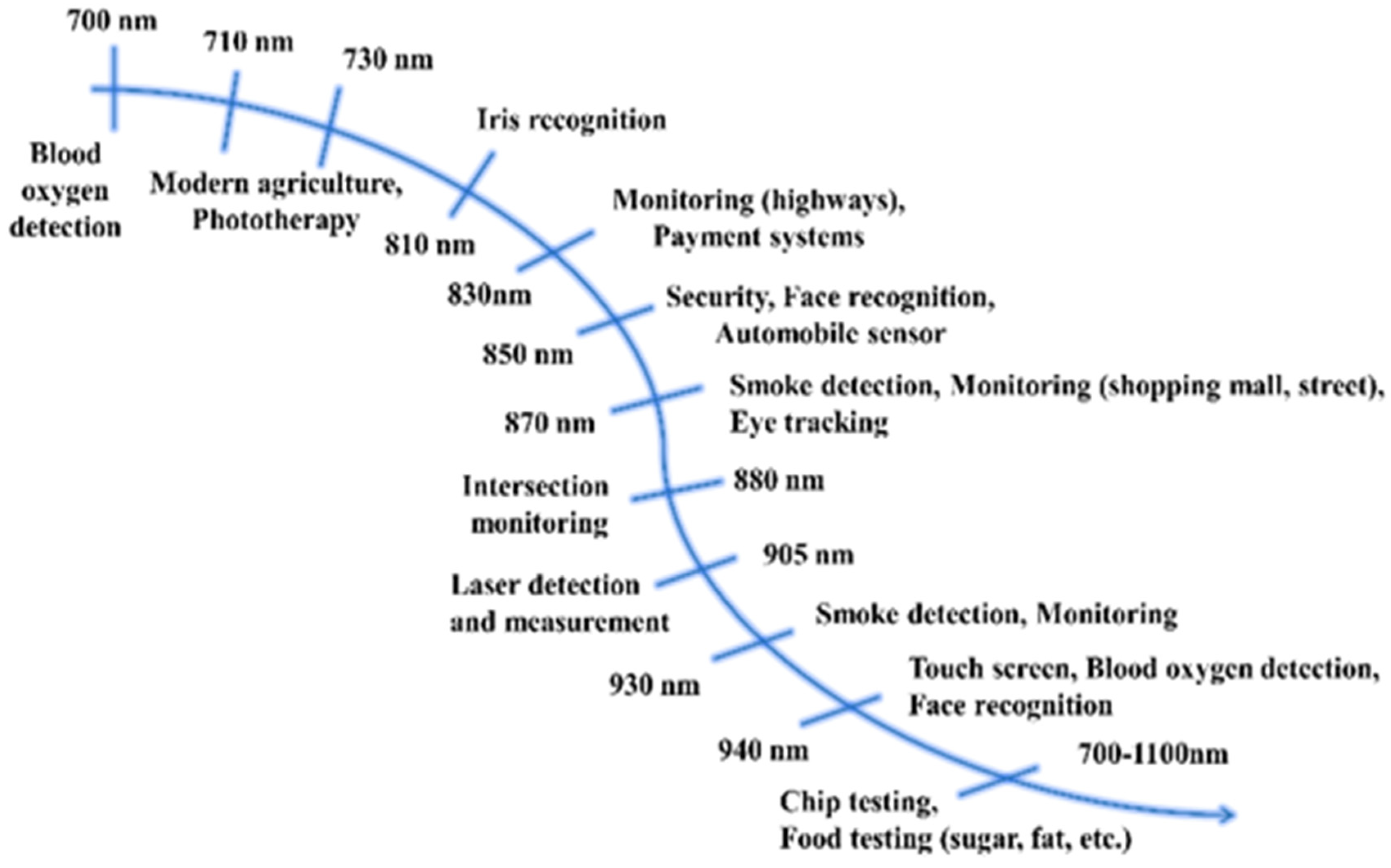
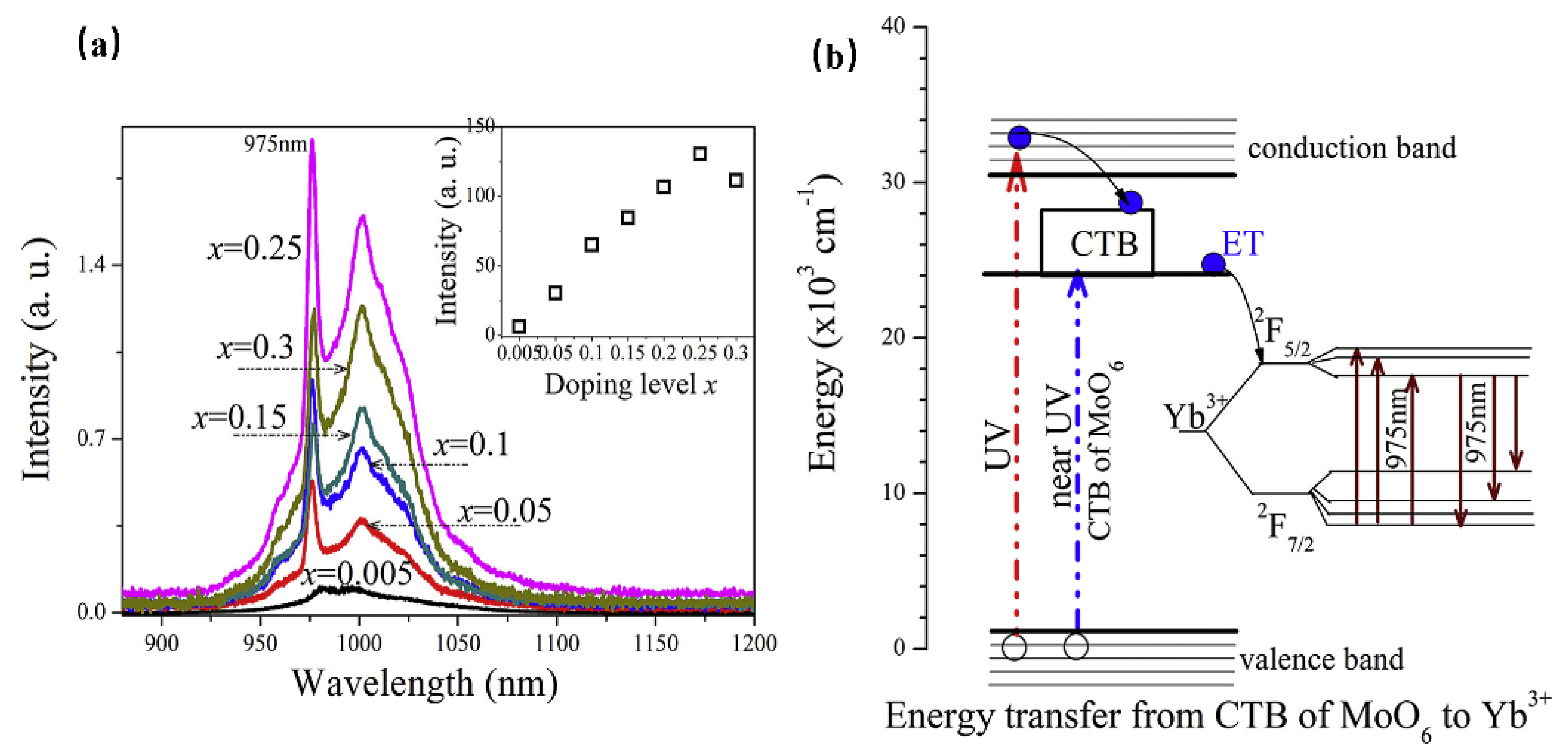
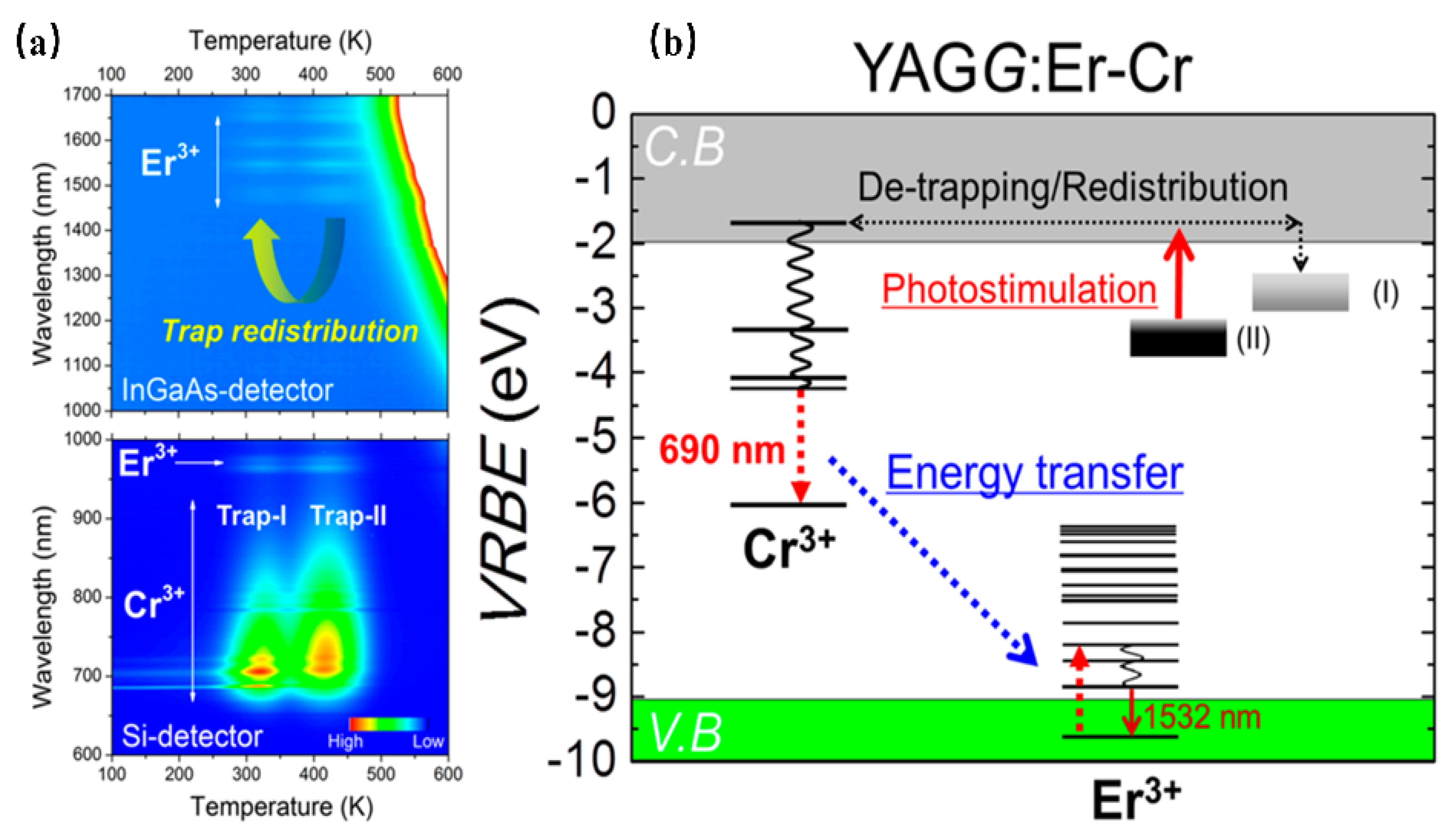

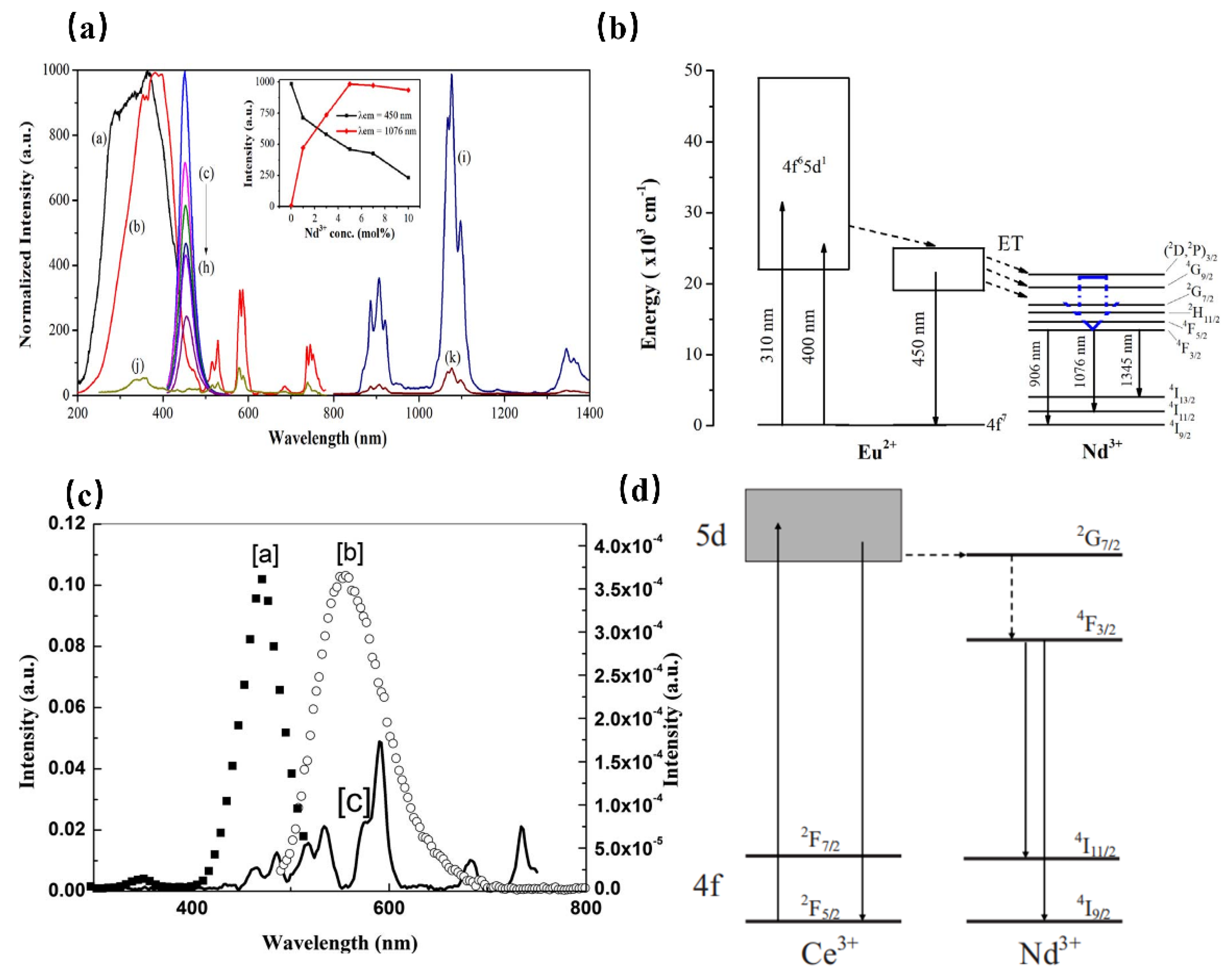
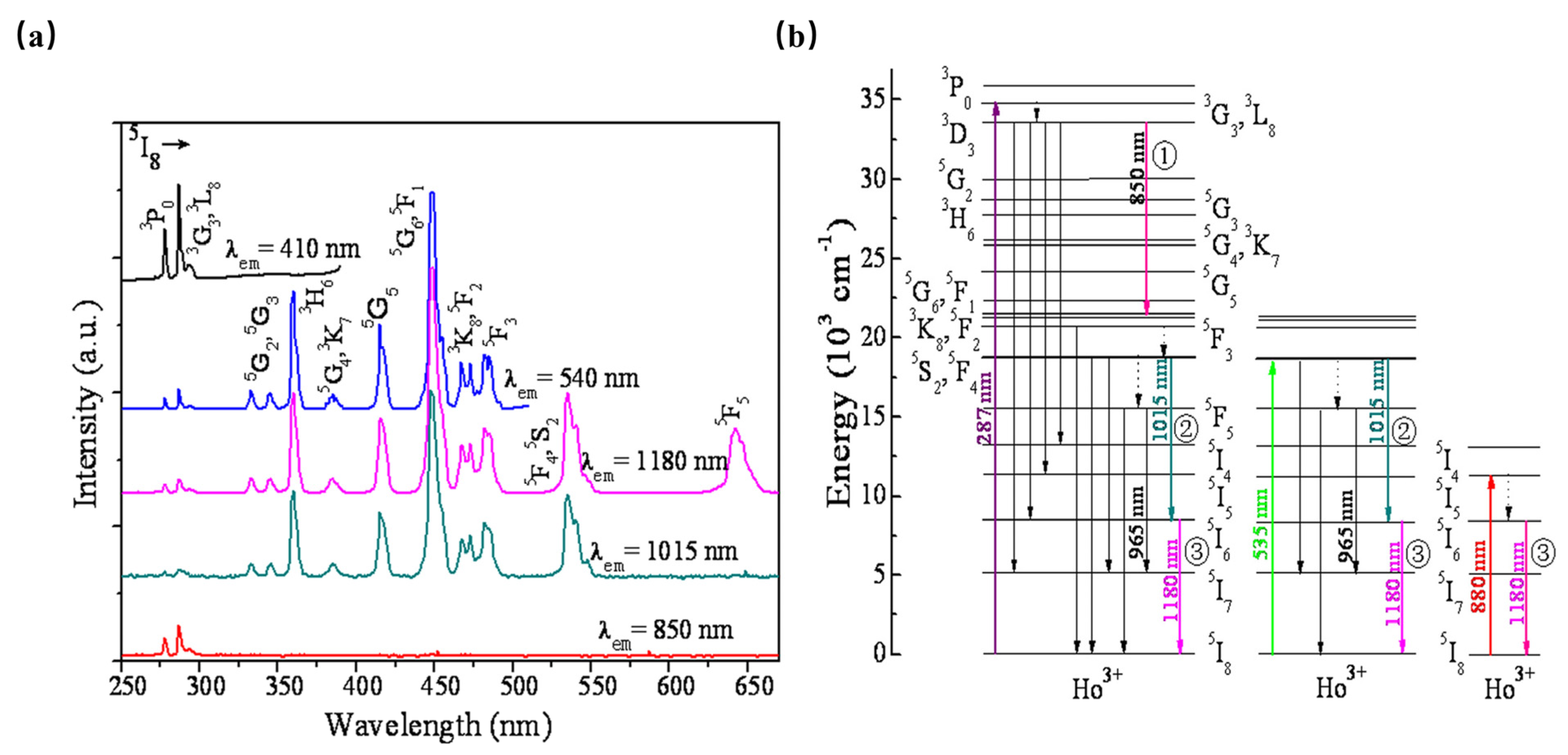
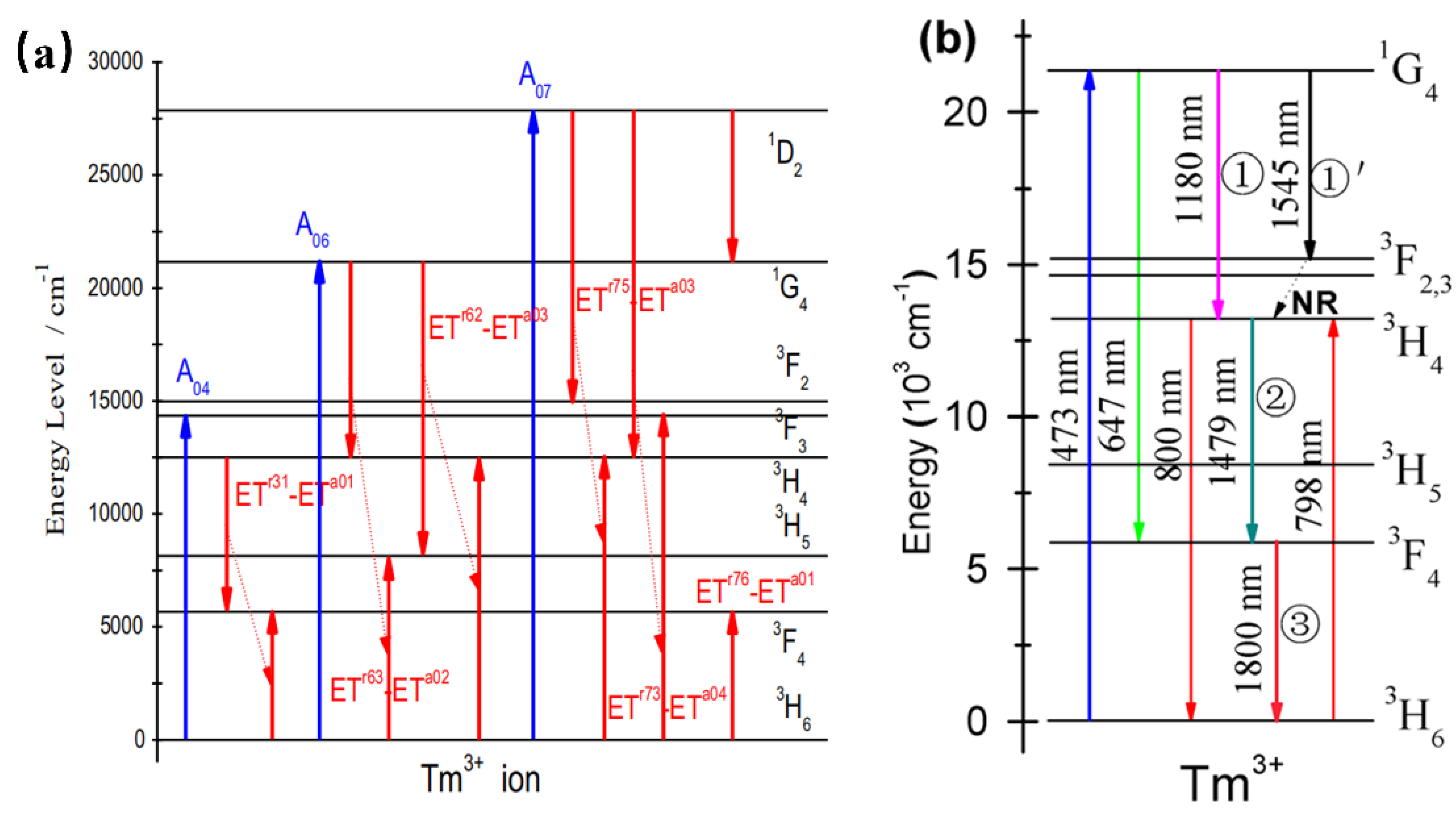

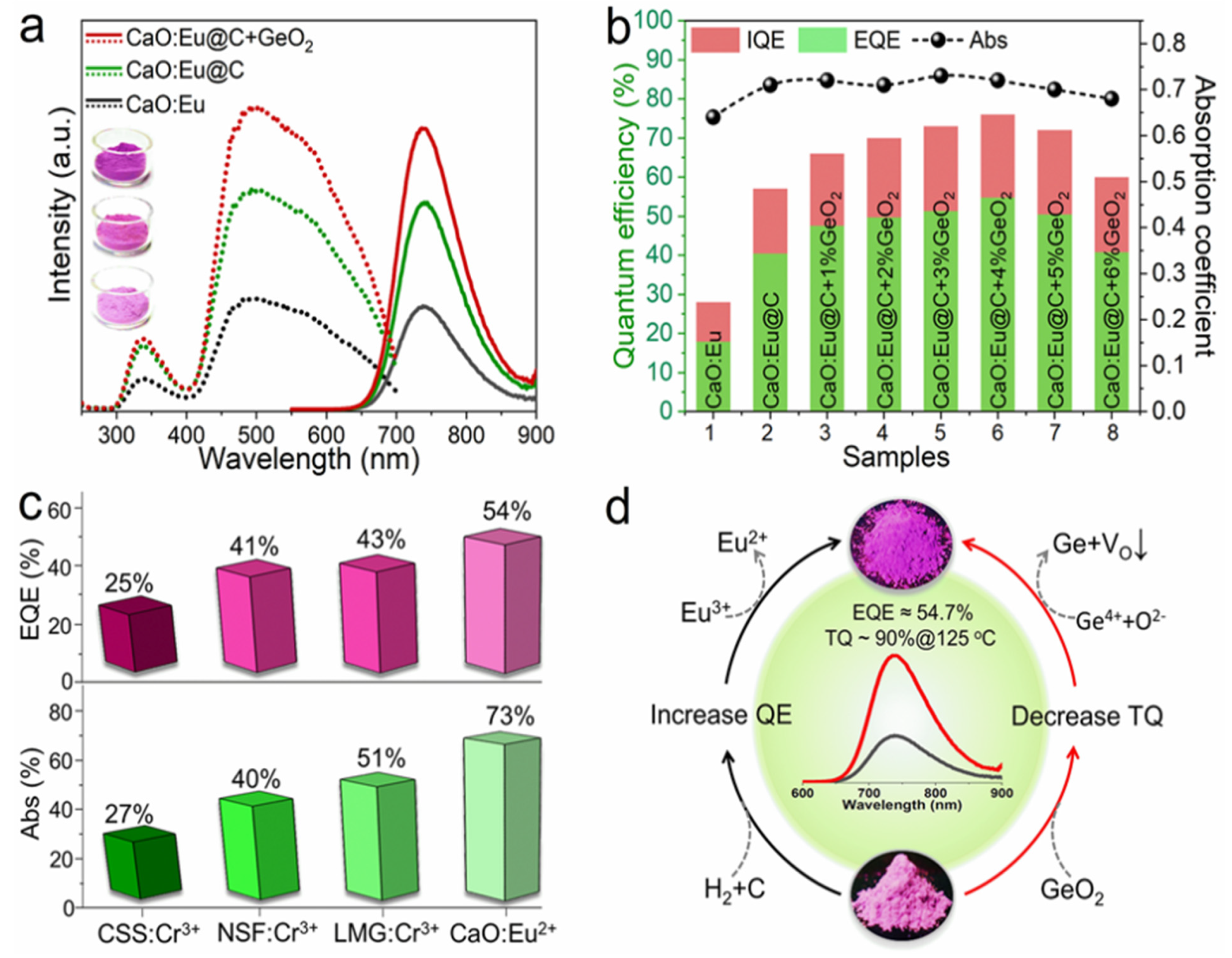

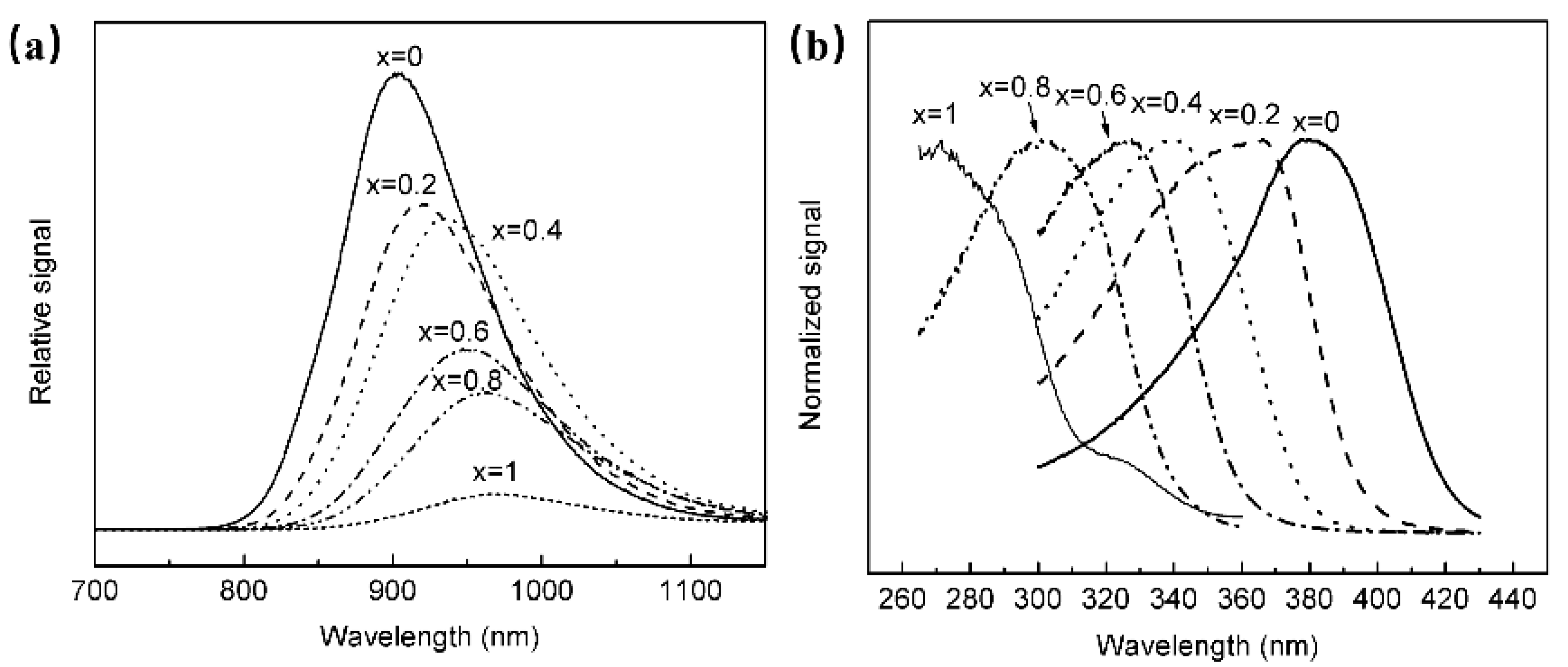

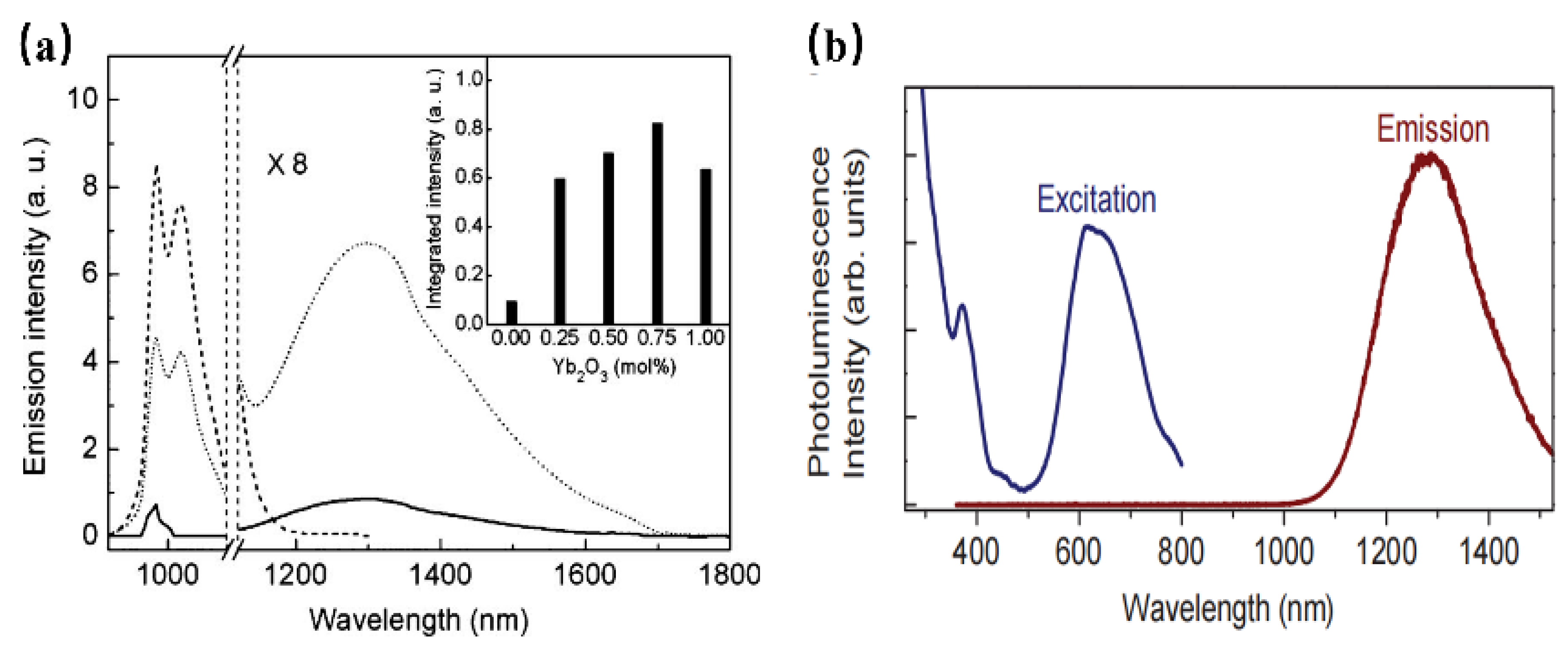
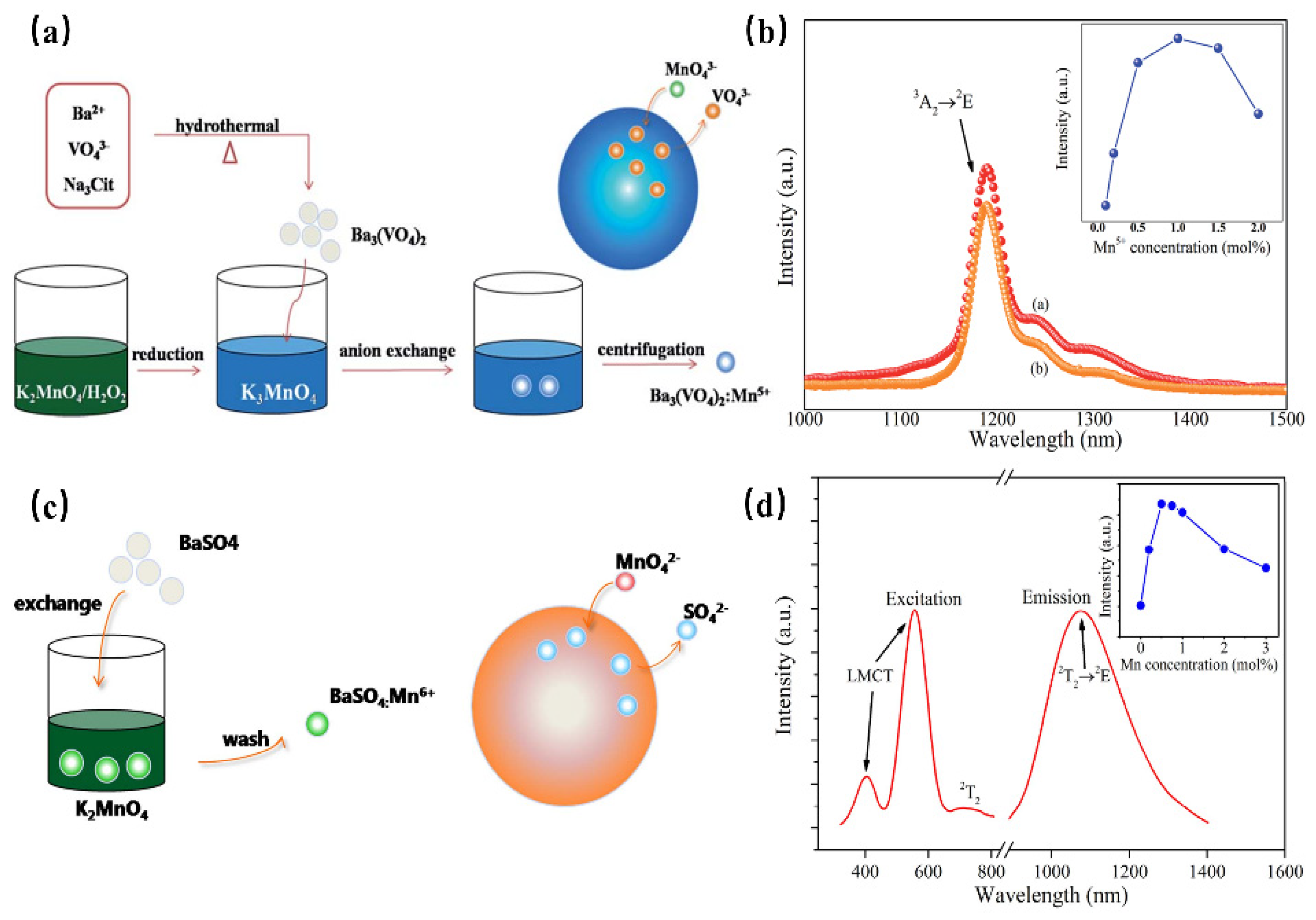


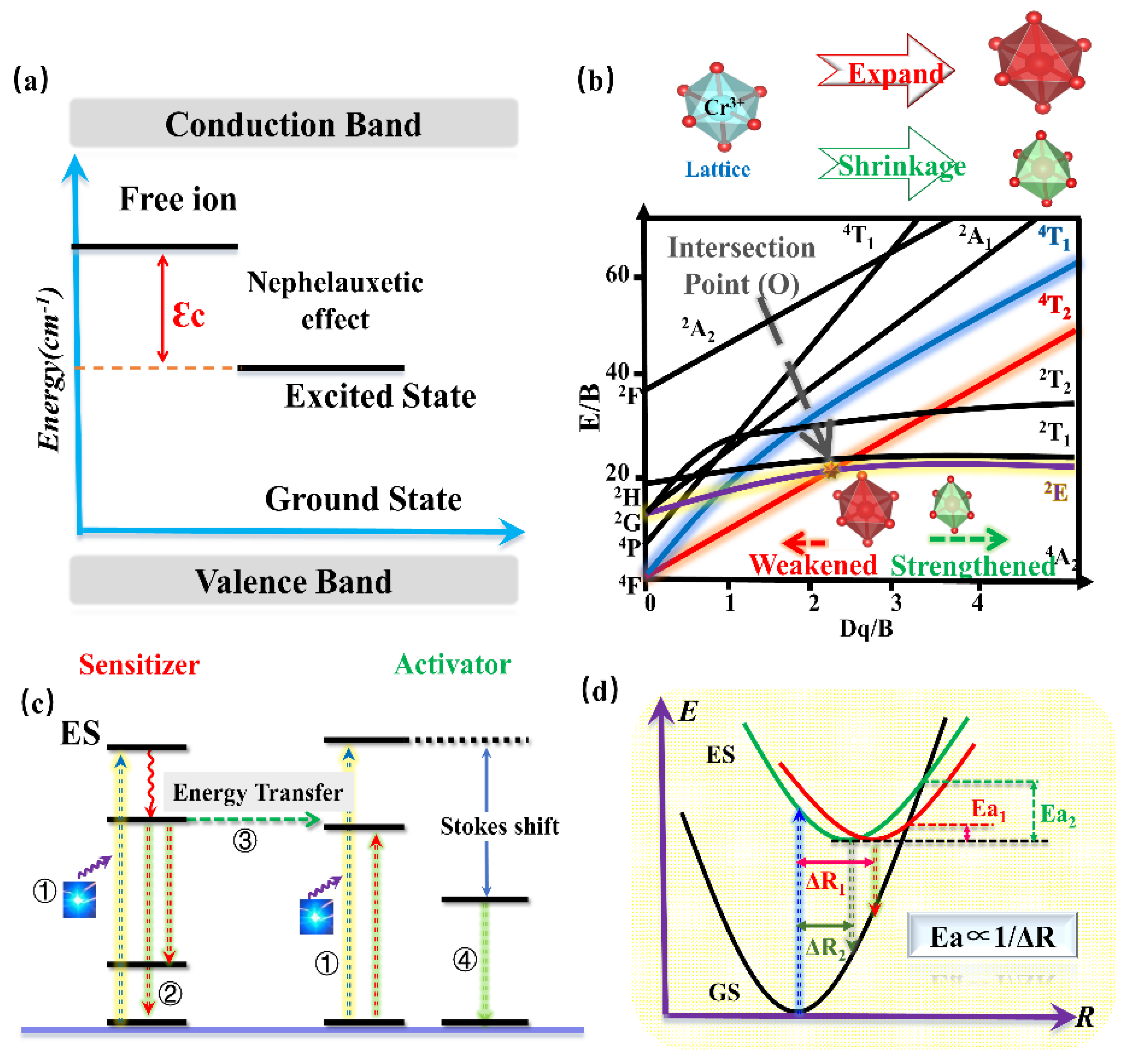
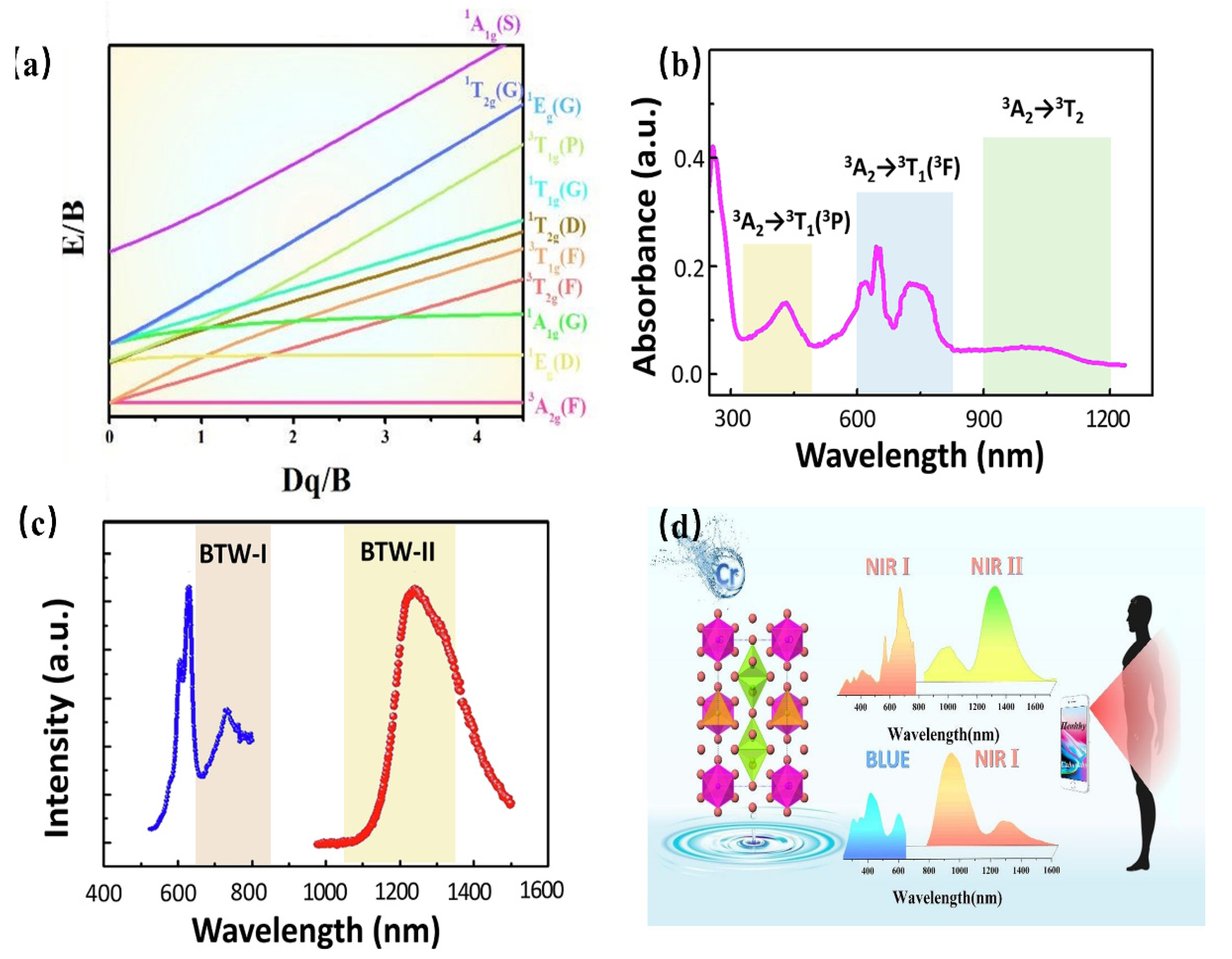
| Phosphors | λmax (nm) | FWHM (nm) | Efficiency | Photoelectric Efficiency/Light Output | Reference |
|---|---|---|---|---|---|
| ScF3:Cr3+ | 853 | 140 | IQE = 45% | [76] | |
| K2NaScF6: Cr3+ | 765 | 100 | IQE = 74% | [87] | |
| Na3AlF6: Cr3+ | 720 | 95 | QY = 75% | ||
| ScBO3: Cr3+ | 800 | 120 | QY = 72.8% | 39.11 mW @350 mA | [88] |
| LiScP2O7: Cr3+ | 880 | 170 | IQY = 74% | [89] | |
| Ca2LuHf2Al3O12: Cr3+ | 785 | 145 | [90] | ||
| Ca2LuZr2Al3O12: Cr3+ | 752 | 117 | IQE = 69.1% EQE = 31.6% | 750–820 nm 4.1%; 350–1100 nm 8.51% @20 mA | [63] |
| LiInSi2O6: Cr3+ | 840 | 143 | QY = 75% | 17.8% @100 mA/ 51.6 mW @100 mA 3V | [91] |
| Mg7Ga2GeO12:Cr3+ | 800 | 266 | IQE = 86% EQE = 37% | [92] | |
| Li2Sr2Al(PO4)3 | 823 | 178 | IQE = 61% | [93] | |
| Ca3Sc2Si3O12: Cr3+ | 770 | 110 | IQE = 92.3% | 109.9 mW @520 mA | [94] |
| LaMgGa11O19: Cr3+ | 770 | 138 | IQE = 82.6% EQE = 42.5% | [95] | |
| Ca2LuScGa2Ge2O12: Cr3+ | 800 | 150 | 1.213 mW @0.4% | [96] | |
| La2MgZrO6: Cr3+ | 825 | 210 | IQE = ~56% EQE = ~17.9% | [97] | |
| Lu3Sc2Ga3O12: Cr3+ | 722 | 73 | QE = ~60% | [98] | |
| YAl3(BO3)4: Cr3+ | 720 | 110 | QY = ~86.7% | the light output power of ~50.6 mW and energy conversion efficiency of ~17.4% at 100 mA drive current | [99] |
Disclaimer/Publisher’s Note: The statements, opinions and data contained in all publications are solely those of the individual author(s) and contributor(s) and not of MDPI and/or the editor(s). MDPI and/or the editor(s) disclaim responsibility for any injury to people or property resulting from any ideas, methods, instructions or products referred to in the content. |
© 2023 by the authors. Licensee MDPI, Basel, Switzerland. This article is an open access article distributed under the terms and conditions of the Creative Commons Attribution (CC BY) license (https://creativecommons.org/licenses/by/4.0/).
Share and Cite
Gao, T.; Liu, Y.; Liu, R.; Zhuang, W. Research Progress and Development of Near-Infrared Phosphors. Materials 2023, 16, 3145. https://doi.org/10.3390/ma16083145
Gao T, Liu Y, Liu R, Zhuang W. Research Progress and Development of Near-Infrared Phosphors. Materials. 2023; 16(8):3145. https://doi.org/10.3390/ma16083145
Chicago/Turabian StyleGao, Tongyu, Yuanhong Liu, Ronghui Liu, and Weidong Zhuang. 2023. "Research Progress and Development of Near-Infrared Phosphors" Materials 16, no. 8: 3145. https://doi.org/10.3390/ma16083145




